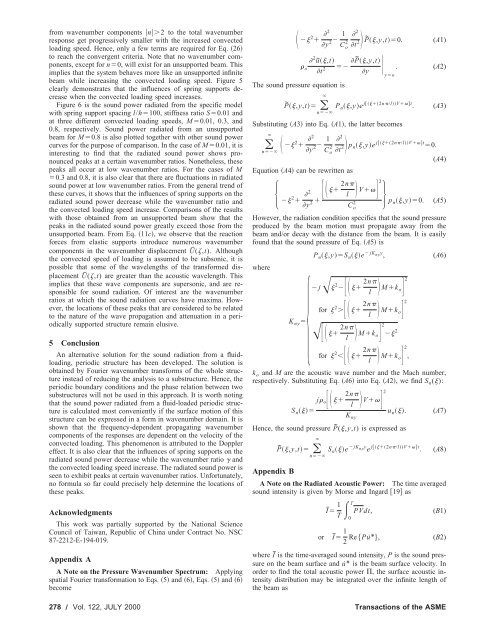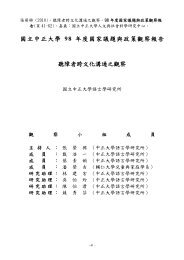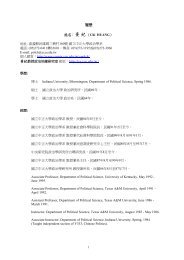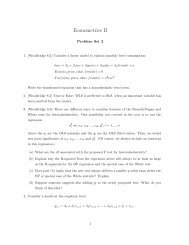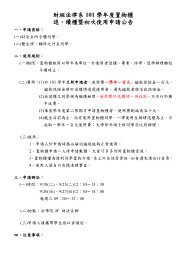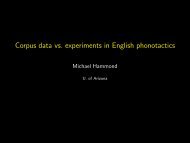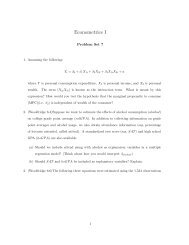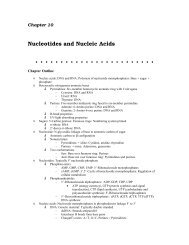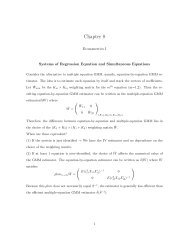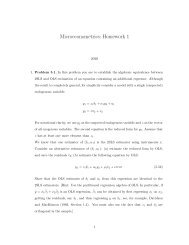Using ASME format
Using ASME format
Using ASME format
- No tags were found...
Create successful ePaper yourself
Turn your PDF publications into a flip-book with our unique Google optimized e-Paper software.
from wavenumber components n2 to the total wavenumberresponse get progressively smaller with the increased convectedloading speed. Hence, only a few terms are required for Eq. 26to reach the convergent criteria. Note that no wavenumber components,except for n0, will exist for an unsupported beam. Thisimplies that the system behaves more like an unsupported infinitebeam while increasing the convected loading speed. Figure 5clearly demonstrates that the influences of spring supports decreasewhen the convected loading speed increases.Figure 6 is the sound power radiated from the specific modelwith spring support spacing l/h100, stiffness ratio S0.01 andat three different convected loading speeds, M0.01, 0.3, and0.8, respectively. Sound power radiated from an unsupportedbeam for M0.8 is also plotted together with other sound powercurves for the purpose of comparison. In the case of M0.01, it isinteresting to find that the radiated sound power shows pronouncedpeaks at a certain wavenumber ratios. Nonetheless, thesepeaks all occur at low wavenumber ratios. For the cases of M0.3 and 0.8, it is also clear that there are fluctuations in radiatedsound power at low wavenumber ratios. From the general trend ofthese curves, it shows that the influences of spring supports on theradiated sound power decrease while the wavenumber ratio andthe convected loading speed increase. Comparisons of the resultswith those obtained from an unsupported beam show that thepeaks in the radiated sound power greatly exceed those from theunsupported beam. From Eq. 11c, we observe that the reactionforces from elastic supports introduce numerous wavenumbercomponents in the wavenumber displacement Ū(,t). Althoughthe convected speed of loading is assumed to be subsonic, it ispossible that some of the wavelengths of the transformed displacementŪ(,t) are greater than the acoustic wavelength. Thisimplies that these wave components are supersonic, and are responsiblefor sound radiation. Of interest are the wavenumberratios at which the sound radiation curves have maxima. However,the locations of these peaks that are considered to be relatedto the nature of the wave propagation and attenuation in a periodicallysupported structure remain elusive.5 ConclusionAn alternative solution for the sound radiation from a fluidloading,periodic structure has been developed. The solution isobtained by Fourier wavenumber transforms of the whole structureinstead of reducing the analysis to a substructure. Hence, theperiodic boundary conditions and the phase relation between twosubstructures will not be used in this approach. It is worth notingthat the sound power radiated from a fluid-loaded periodic structureis calculated most conveniently if the surface motion of thisstructure can be expressed in a form in wavenumber domain. It isshown that the frequency-dependent propagating wavenumbercomponents of the responses are dependent on the velocity of theconvected loading. This phenomenon is attributed to the Dopplereffect. It is also clear that the influences of spring supports on theradiated sound power decrease while the wavenumber ratio andthe convected loading speed increase. The radiated sound power isseen to exhibit peaks at certain wavenumber ratios. Unfortunately,no formula so far could precisely help determine the locations ofthese peaks.AcknowledgmentsThis work was partially supported by the National ScienceCouncil of Taiwan, Republic of China under Contract No. NSC87-2212-E-194-019.Appendix AA Note on the Pressure Wavenumber Spectrum: Applyingspatial Fourier trans<strong>format</strong>ion to Eqs. 5 and 6, Eqs. 5 and 6becomen 2 2y 2 1 2 22 P˜ ,y,t0.C ot(A1) 2 ũ,t P˜ ,y,t ot 2 . (A2)yyoThe sound pressure equation isP˜ ,y,tn P n ,ye j2n/lVt . (A3)Substituting A3 into Eq. A1, the latter becomes 2 2y 2 1 2 22 pC ot n ,ye j2n/lVt 0.Equation A4 can be rewritten as 2nl 2 2y 2 2 V(A4)C o2p n ,y0. (A5)However, the radiation condition specifies that the sound pressureproduced by the beam motion must propagate away from thebeam and/or decay with the distance from the beam. It is easilyfound that the sound pressure of Eq. A5 isP n ,yS n e jK ny y ,(A6)wherej K ny ¦ 2 2nlfor 2 2nl 2nlfor 2 Mk o2 2nl Mk o2 Mk o2 2 Mk o2,k o and M are the acoustic wave number and the Mach number,respectively. Substituting Eq. A6 into Eq. A2, wefindS n ():j o 2nl2 VS n uK n . (A7)nyHence, the sound pressure P˜ (,y,t) is expressed asAppendix BP˜ ,y,tn S n e jK ny y e j2n/lVt .(A8)A Note on the Radiated Acoustic Power: The time averagedsound intensity is given by Morse and Ingard 19 asTĪ 1 PVdt,T0(B1)or Ī 1 Re Pu˙ *, (B2)2where Ī is the time-averaged sound intensity, P is the sound pressureon the beam surface and u˙ * is the beam surface velocity. Inorder to find the total acoustic power , the surface acoustic intensitydistribution may be integrated over the infinite length ofthe beam as278 Õ Vol. 122, JULY 2000 Transactions of the <strong>ASME</strong>


